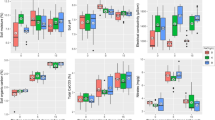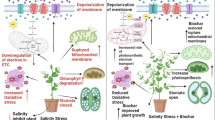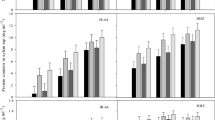Abstract
Purpose
Plant growth and grain yield of most of the crops are reduced on saline-sodic soils. Different organic and inorganic amendments have been used to increase plant growth and productivity on salt-affected soils. However, the role of cotton shell biochar (CSBC) for increasing salt tolerance of plants grown on saline-sodic soils has not been investigated yet. Therefore, the current study was intended to estimate the impact of cotton shell biochar (CSBC) addition @1 and 2% for ameliorating Na-induced phytotoxicity in quinoa grown on saline-sodic soil.
Materials and methods
Quinoa plants were grown on saline-sodic soil with and without CSBC addition. Different physiological attributes were measured at vegetative stage. Plants were harvested at maturity when growth and grain yield were recorded.
Results and discussion
Results revealed that plant biomass, grain yield, stomatal conductance, relative water contents, and chlorophyll contents of quinoa were declined by > 20%, 18%, 23%, 27%, and 16%, respectively under salt stress. Excessive uptake of Na decreased the uptake of K and K:Na, and caused the overproduction of H2O2 (62%) and lipid peroxidation (58%) in quinoa. The CSBC addition @2% was more effective than 1% in ameliorating the negative impacts of Na toxicity on plant growth and physiology. Amendment of saline-sodic soil with 2% CSBC increased plant growth, water contents, stomatal conductance, and chlorophyll contents by 60%, 36%, 41%, and 43%, respectively as compared to saline-sodic soil without CSBC. There was a slight increase in soil EC after the addition of CSBC. Additionally, 2% CSBC limited the uptake of Na and caused a 43%, 48%, and 75% increase in superoxide dismutase (SOD), catalase (CAT), and peroxidase (POD) activities to ameliorate the oxidative stress.
Conclusions
It was concluded through multivariate analysis that 2% CSBC was very promising in reducing Na toxicity and increasing plant biomass and grain yield of quinoa in saline-sodic soils.






Similar content being viewed by others
References
Abbas G, Amjad M, Saqib M et al (2021) Soil sodicity is more detrimental than salinity for quinoa (Chenopodium quinoa Willd.): a multivariate comparison of physiological, biochemical and nutritional quality attributes. J Agron Crop Sci. https://doi.org/10.1111/jac.12451
Abbas G, Chen Y, Khan FY et al (2018a) Salinity and low phosphorus differentially affect shoot and root traits in two wheat cultivars with contrasting tolerance to salt. Agronomy. https://doi.org/10.3390/agronomy8080155
Abbas G, Murtaza B, Bibi I et al (2018b) Arsenic uptake, toxicity, detoxification, and speciation in plants: physiological, biochemical, and molecular aspects. Int J Environ Res Public Health
Abrar MM, Saqib M, Abbas G et al (2020) Evaluating the contribution of growth, physiological, and ionic components towards salinity and drought stress tolerance in Jatropha curcas. Plants. https://doi.org/10.3390/plants9111574
Aebi H (1984) [13] Catalase in vitro. Methods Enzymol. https://doi.org/10.1016/S0076-6879(84)05016-3
Akhtar SS, Andersen MN, Liu F (2015a) Biochar mitigates salinity stress in potato. J Agron Crop Sci. https://doi.org/10.1111/jac.12132
Akhtar SS, Andersen MN, Liu F (2015b) Residual effects of biochar on improving growth, physiology and yield of wheat under salt stress. Agric Water Manag. https://doi.org/10.1016/j.agwat.2015.04.010
Akhtar SS, Andersen MN, Naveed M et al (2015c) Interactive effect of biochar and plant growth-promoting bacterial endophytes on ameliorating salinity stress in maize. Funct Plant Biol. https://doi.org/10.1071/FP15054
Amini S, Ghadiri H, Chen C, Marschner P (2016) Salt-affected soils, reclamation, carbon dynamics, and biochar: a review. J Soils Sediments 16(3):939–953. https://doi.org/10.1007/s11368-015-1293-1
Bazile D, Jacobsen S-E, Verniau A (2016) The global expansion of quinoa: trends and limits. Front Plant Sci. https://doi.org/10.3389/fpls.2016.00622
Cakmak I (2005) The role of potassium in alleviating detrimental effects of abiotic stresses in plants. In: Journal of Plant Nutrition and Soil Science. John Wiley & Sons, Ltd, pp 521–530
Chakraborty K, Bhaduri D, Meena HN, Kalariya K (2016) External potassium (K+) application improves salinity tolerance by promoting Na+-exclusion, K+-accumulation and osmotic adjustment in contrasting peanut cultivars. Plant Physiol Biochem. https://doi.org/10.1016/j.plaphy.2016.02.039
Chapman HD, Pratt PF (1961) Methods of analysis for soils, plants and waters. University of California, Los Angeles, 60-61:150–179
Cornelissen G, Martinsen V, Shitumbanuma V et al (2013) Biochar effect on maize yield and soil characteristics in five conservation farming sites in Zambia. Agronomy. https://doi.org/10.3390/agronomy3020256
Dhindsa RS, Plumb-dhindsa P, Thorpe TA (1981) Leaf senescence: correlated with increased levels of membrane permeability and lipid peroxidation, and decreased levels of superoxide dismutase and catalase. J Exp Bot. https://doi.org/10.1093/jxb/32.1.93
Ding Z, Kheir AM, Ali MG, Ali OA, Abdelaal AI, Zhou Z, Wang B, Liu B, He Z (2020) The integrated effect of salinity, organic amendments, phosphorus fertilizers, and deficit irrigation on soil properties, phosphorus fractionation and wheat productivity. Sci Rep 10(1):1–13
Flexas J, Bota J, Loreto F et al (2004) Diffusive and metabolic limitations to photosynthesis under drought and salinity in C3 plants. Plant Biol 6(03):269–279
Flowers TJ, Munns R, Colmer TD (2015) Sodium chloride toxicity and the cellular basis of salt tolerance in halophytes. Ann Bot 115(3):419–431
Gul S, Whalen JK, Thomas BW et al (2015) Physico-chemical properties and microbial responses in biochar-amended soils: mechanisms and future directions. Agric Ecosyst Environ 206:46–59
Hammer EC, Forstreuter M, Rillig MC, Kohler J (2015) Biochar increases arbuscular mycorrhizal plant growth enhancement and ameliorates salinity stress. Appl Soil Ecol. https://doi.org/10.1016/j.apsoil.2015.07.014
He K, He G, Wang C et al (2020) Biochar amendment ameliorates soil properties and promotes Miscanthus growth in a coastal saline-alkali soil. Appl Soil Ecol. https://doi.org/10.1016/j.apsoil.2020.103674
Hemeda HM, Klein BP (1990) Effects of naturally occurring antioxidants on peroxidase activity of vegetable extracts. J Food Sci. https://doi.org/10.1111/j.1365-2621.1990.tb06048.x
Hodges DM, DeLong JM, Forney CF, Prange RK (1999) Improving the thiobarbituric acid-reactive-substances assay for estimating lipid peroxidation in plant tissues containing anthocyanin and other interfering compounds. Planta. https://doi.org/10.1007/s004250050524
Hu Y, Hackl H, Schmidhalter U (2017) Comparative performance of spectral and thermographic properties of plants and physiological traits for phenotyping salinity tolerance of wheat cultivars under simulated field conditions. Funct Plant Biol. https://doi.org/10.1071/FP16217
Hu Y, Schmidhalter U (2005) Drought and salinity: a comparison of their effects on mineral nutrition of plants. J Plant Nutr Soil Sci 168:541–549
Huang M, Zhang Z, Zhu C, Zhai Y, Lu P (2019) Effect of biochar on sweet corn and soil salinity under conjunctive irrigation with brackish water in coastal saline soil. Sci Hort 250:405–413
Iqbal S, Basra SMA, Afzal I et al (2019) Yield potential and salt tolerance of quinoa on salt-degraded soils of Pakistan. J Agron Crop Sci. https://doi.org/10.1111/jac.12290
Irshad A, Rehman RNU, Abrar MM et al (2021) Contribution of rhizobium–legume symbiosis in salt stress tolerance in Medicago truncatula evaluated through photosynthesis, antioxidant enzymes, and compatible solutes accumulation. Sustain. https://doi.org/10.3390/su13063369
Islam E, Liu D, Li T et al (2008) Effect of Pb toxicity on leaf growth, physiology and ultrastructure in the two ecotypes of Elsholtzia argyi. J Hazard Mater. https://doi.org/10.1016/j.jhazmat.2007.10.121
Jacobsen SE, Mujica A, Jensen CR (2003) The resistance of quinoa (Chenopodium quinoa Willd.) to adverse abiotic factors. In: Food Reviews International
Jin F, Ran C, Anwari Q et al (2018) Effects of biochar on sodium ion accumulation, yield and quality of rice in saline-sodic soil of the west of Songnen plain, Northeast China. Plant, Soil Environ. https://doi.org/10.17221/359/2018-PSE
Kannan V, Srinivasan G, Babu R et al (2017) Effect of biochar, mulch and ppfm spray on leaf relative water content, leaf proline, chlorophyll stability index and yield of cotton under moisture stress condition. Int J Curr Microbiol Appl Sci. https://doi.org/10.20546/ijcmas.2017.606.071
Lashari MS, Ye Y, Ji H et al (2015) Biochar-manure compost in conjunction with pyroligneous solution alleviated salt stress and improved leaf bioactivity of maize in a saline soil from central China: a 2-year field experiment. J Sci Food Agric. https://doi.org/10.1002/jsfa.6825
Lichtenthaler HK (1987) Chlorophylls and carotenoids: pigments of photosynthetic biomembranes. Methods Enzymol. https://doi.org/10.1016/0076-6879(87)48036-1
Mansoor S, Kour N, Manhas S et al (2021) Biochar as a tool for effective management of drought and heavy metal toxicity. Chemosphere. https://doi.org/10.1016/j.chemosphere.2020.129458
Marschner H (1995) Mineral nutrition of higher plants. Second edition. Academic Press. London, 889pp
Mehdizadeh L, Moghaddam M, Lakzian A (2020) Amelioration of soil properties, growth and leaf mineral elements of summer savory under salt stress and biochar application in alkaline soil. Sci Hort 267:109319
Munns R, Tester M (2008) Mechanisms of salinity tolerance. Annu Rev Plant Biol 59:651–681
Naeem I, Masood N, Turan V, Iqbal M (2021) Prospective usage of magnesium potassium phosphate cement combined with Bougainvillea alba derived biochar to reduce Pb bioavailability in soil and its uptake by Spinacia oleracea L. Ecotoxicol Environ Saf. https://doi.org/10.1016/j.ecoenv.2020.111723
Naeem MA, Khalid M, Aon M et al (2017) Effect of wheat and rice straw biochar produced at different temperatures on maize growth and nutrient dynamics of a calcareous soil. Arch Agron Soil Sci. https://doi.org/10.1080/03650340.2017.1325468
Natasha N, Shahid M, Khalid S et al (2021) Influence of biochar on trace element uptake, toxicity and detoxification in plants and associated health risks: a critical review. Crit Rev Environ Sci Technol. https://doi.org/10.1080/10643389.2021.1894064
Novak JM, Busscher WJ, Watts DW et al (2012) Biochars impact on soil-moisture storage in an ultisol and two aridisols. Soil Sci. https://doi.org/10.1097/SS.0b013e31824e5593
Parvez S, Abbas G, Shahid M et al (2020) Effect of salinity on physiological, biochemical and photostabilizing attributes of two genotypes of quinoa (Chenopodium quinoa Willd.) exposed to arsenic stress. Ecotoxicol Environ Saf. https://doi.org/10.1016/j.ecoenv.2019.109814
Pulvento C, Riccardi M, Lavini A et al (2012) Yield and quality characteristics of quinoa grown in open field under different saline and non-saline irrigation regimes. J Agron Crop Sci. https://doi.org/10.1111/j.1439-037X.2012.00509.x
Qadir M, Quillérou E, Nangia V et al (2014) Economics of salt-induced land degradation and restoration. Nat Resour Forum 38:282–295. https://doi.org/10.1111/1477-8947.12054
Rafiq M, Shahid M, Abbas G et al (2017) Comparative effect of calcium and EDTA on arsenic uptake and physiological attributes of Pisum sativum. Int J Phytoremediation. https://doi.org/10.1080/15226514.2016.1278426
Ruiz KB, Biondi S, Martínez EA et al (2016) Quinoa – a model crop for understanding salt-tolerance mechanisms in halophytes. Plant Biosyst. https://doi.org/10.1080/11263504.2015.1027317
Saifullah, Dahlawi S, Naeem A et al (2018) Biochar application for the remediation of salt-affected soils: Challenges and opportunities. Sci Total Environ
Sairam RK, Rao K, Srivastava GC (2002) Differential response of wheat genotypes to long term salinity stress in relation to oxidative stress, antioxidant activity and osmolyte concentration. Plant Sci 163:1037–1046. https://doi.org/10.1016/S0168-9452(02)00278-9
Sánchez ME, Lindao E, Margaleff D et al (2009) Pyrolysis of agricultural residues from rape and sunflowers: production and characterization of bio-fuels and biochar soil management. J Anal Appl Pyrolysis. https://doi.org/10.1016/j.jaap.2008.11.001
Shabala S, Hariadi Y, Jacobsen SE (2013) Genotypic difference in salinity tolerance in quinoa is determined by differential control of xylem Na+ loading and stomatal density. J Plant Physiol. https://doi.org/10.1016/j.jplph.2013.01.014
Shabbir A, Saqib M, Murtaza G et al (2021) Biochar mitigates arsenic-induced human health risks and phytotoxicity in quinoa under saline conditions by modulating ionic and oxidative stress responses. Environ Pollut. https://doi.org/10.1016/j.envpol.2021.117348
She D, Sun X, Gamareldawla AHD et al (2018) Benefits of soil biochar amendments to tomato growth under saline water irrigation. Sci Rep. https://doi.org/10.1038/s41598-018-33040-7
Singh AP, Dixit G, Kumar A et al (2017) A protective role for nitric oxide and salicylic acid for arsenite phytotoxicity in rice (Oryza sativa L.). Plant Physiol Biochem. https://doi.org/10.1016/j.plaphy.2017.02.019
Steel R (1997) Analysis of variance I : the one-way classification. Princ Proced Stat A Biometrical Approach 139–203
Seleiman MF, Kheir AM (2018) Saline soil properties, quality and productivity of wheat grown with bagasse ash and thiourea in different climatic zones. Chemosphere 193:538–546
Tanure MMC, da Costa LM, Huiz HA et al (2019) Soil water retention, physiological characteristics, and growth of maize plants in response to biochar application to soil. Soil Tillage Res. https://doi.org/10.1016/j.still.2019.05.007
Wicke B, Smeets E, Dornburg V et al (2020) Correction: The global technical and economic potential of bioenergy from salt-affected soils. Energy Environ Sci. https://doi.org/10.1039/d0ee90035d
Zheng H, Wang X, Chen L et al (2018) Enhanced growth of halophyte plants in biochar-amended coastal soil: roles of nutrient availability and rhizosphere microbial modulation. Plant Cell Environ. https://doi.org/10.1111/pce.12944
Acknowledgements
Authors would like to extend their sincere appreciation to the Researchers Supporting Project number (RSP-2021/347) King Saud University, Riyadh, Saudi Arabia. The authors are highly thankful to COMSATS University Islamabad, Vehari Campus for providing research facilities.
Author information
Authors and Affiliations
Corresponding authors
Ethics declarations
Conflict of interest
The authors declare that they have no conflict of interest.
Additional information
Responsible editor: Hailong Wang
Publisher's Note
Springer Nature remains neutral with regard to jurisdictional claims in published maps and institutional affiliations.
Rights and permissions
About this article
Cite this article
Abbas, G., Abrar, M.M., Naeem, M.A. et al. Biochar increases salt tolerance and grain yield of quinoa on saline-sodic soil: multivariate comparison of physiological and oxidative stress attributes. J Soils Sediments 22, 1446–1459 (2022). https://doi.org/10.1007/s11368-022-03159-2
Received:
Accepted:
Published:
Issue Date:
DOI: https://doi.org/10.1007/s11368-022-03159-2




